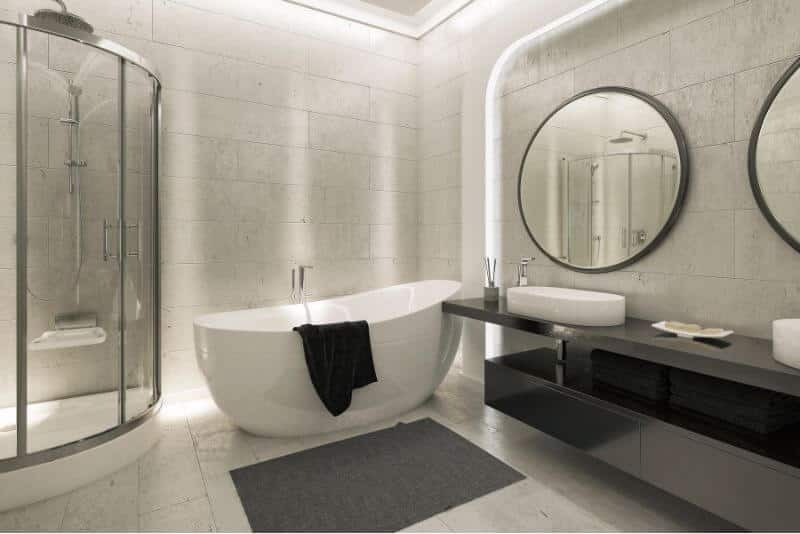Picture this: You’re excited about transforming your outdated bathroom into a modern, stylish oasis. You’ve picked out your dream tiles, the perfect vanity, and a sleek new shower. But then, reality hits—how long will you be without a functioning bathroom?
If you’re wondering, How long does a bathroom remodel take in Windsor, CO?, you’re not alone. Many homeowners face this question when planning their renovations. The timeline varies based on factors like project scope, contractor availability, permit approvals, and unexpected delays.
In this guide, we’ll break down the remodeling timeline, highlight state-specific factors that can impact your project, and share bathroom renovation tips to speed up the process.
How Long Does a Bathroom Remodel Take: Average Timelines

A typical bathroom remodel can take anywhere from 2 to 8 weeks, depending on the complexity of the renovation. Here’s a general breakdown:
Cosmetic Updates (1-2 weeks)
Quick changes like painting, swapping fixtures, and updating hardware. These minor updates can refresh your bathroom’s look with minimal disruption.
Standard Bathroom Remodel (3-6 weeks)
A full refresh with new flooring, vanity, shower/tub, and lighting, without major layout changes. This is the most common type of remodeling for homeowners.
Extensive Bathroom Overhaul (6-8+ weeks)
If you’re relocating plumbing, changing the layout, or doing a high-end custom remodel, expect a longer timeline. These projects require more planning and specialized work.
Step-by-Step Bathroom Remodel Timeline
-
Planning and Design (1-4 Weeks)
- Finalizing design, choosing materials, and securing necessary permits.
- Working with a contractor at this stage helps prevent delays later.
-
Demolition (1-3 Days)
- Removing old flooring, walls, fixtures, and sometimes plumbing/electrical components.
- Proper disposal of debris ensures a clean work area for the next phase.
-
Plumbing and Electrical Work (1-2 Weeks)
- Moving fixtures or upgrading plumbing and wiring.
- Includes necessary inspections to ensure everything meets code requirements.
-
Structural Work & Drywall (1-2 Weeks)
- Repairing or modifying walls, ceilings, or floors as needed.
- Installing and preparing drywall for painting to create a smooth finish.
-
Flooring, Tile, and Paint (1-2 Weeks)
- Laying flooring and completing tile work for showers and backsplashes.
- Painting walls and ceilings before installing fixtures to avoid splatter.
-
Installing Fixtures & Finishing Touches (1-2 Weeks)
- Installing the vanity, toilet, tub, shower, lighting, and accessories.
- Adding final design elements to bring your vision to life.
-
Final Inspections & Cleanup (A Few Days)
- Ensuring everything meets safety and quality standards.
- A thorough cleanup to make the bathroom ready for use.
The Best Time to Remodel a Bathroom in Windsor, CO
Timing your remodel wisely can help avoid delays and keep costs manageable. Here are some seasonal considerations:
- Spring & Summer – These are peak seasons for home renovations, meaning contractors may be booked up months in advance. However, warmer weather helps with drying times for paint, grout, and adhesives.
- Fall – This is a great time for remodeling as demand for contractors starts to slow down, potentially lowering costs and allowing for faster scheduling.
- Winter – While indoor projects like bathrooms can be done year-round, winter may bring delays due to holiday schedules and shipping disruptions for materials. However, contractor availability is usually better during this time.
Windsor, CO-Specific Factors That Can Affect Your Timeline
- Permit Approvals – Major remodels often require permits for plumbing, electrical, and structural work. Approval can take several days to a few weeks, depending on the county.
- Contractor Availability – Skilled contractors are in high demand, particularly in spring and summer. Booking in advance is recommended.
- Weather Conditions – While most bathroom remodels are indoors, Windsor, CO’s humidity can affect drying times for materials like paint, grout, and adhesives.
- Material Availability – Certain materials may take longer to arrive, especially if they need to be shipped from out of state.
- Unexpected Issues – Older homes may have hidden water damage, outdated plumbing, or structural concerns that require additional time to fix.
Cost vs. Time Trade-Offs
- Budget Constraints – Higher-end remodels with custom elements take longer than budget-friendly updates. Balancing cost and quality can help you set realistic expectations.
- DIY vs. Hiring Professionals – A DIY approach can extend the timeline significantly if you lack experience. Professional help ensures efficiency and reduces costly mistakes.
- Fast-Track Options – Prefabricated components or a one-day remodel can cut down renovation time. Choosing pre-assembled vanities or shower kits can speed up installation.
Common Delays and How to Avoid Them
- Back-ordered Materials – Order materials in advance to prevent waiting.
- Contractor Scheduling Conflicts – Book contractors early and confirm schedules.
- Permit Hold-Ups – Research permit requirements ahead of time and submit applications promptly.
- Unforeseen Repairs – Budget extra time for surprises, especially in older homes.
Alternative Remodeling Options
- Partial Remodels – Focus on key updates like replacing a shower or vanity instead of a full renovation.
- Modular or Prefabricated Solutions – These can speed up installation time significantly.
Tips for Living Through a Bathroom Remodel
- Set Up a Temporary Bathroom – If you have only one bathroom, consider renting a portable shower or using a neighbor’s facilities.
- Minimize Disruption – Work with your contractor to create a schedule that allows some bathroom functionality until completion.
How to Speed Up Your Bathroom Remodel
Plan Ahead
Finalizing your design and ordering materials in advance can prevent delays.
Hire a Reputable Contractor
Experienced professionals can work efficiently and foresee potential problems, so it’s important to hire a bathroom contractor Windsor for your project.
Consider a One-Day or Prefabricated Remodel
If time is a concern, opting for a one-day remodel with prefabricated components can cut down on renovation time.
Conclusion
The length of a bathroom remodel in Windsor, CO depends on the scale of the project and any unforeseen complications. While minor upgrades can be completed in a week, full renovations may take several weeks or even months. Proper planning and choosing the right professionals can help streamline the process and ensure a smooth remodel.
If you’re ready to start your bathroom remodel, consult with a trusted Windsor, CO, contractor to get an accurate bathroom remodel timeline Windsor, CO timeline based on your specific project needs! Taking the time to research and plan thoroughly will help you avoid delays and achieve your ideal bathroom faster.


